One of the simplest ways to attract birds to your yard is by supplementing their natural food sources. To attract the greatest variety of bird species, a feeding program should offer a variety of food. There are four primary food categories: seeds, fruits, suet, and sugar water.
While some birds will sample foods from more than one category, others are more particular. Robins and mockingbirds, for example, may not come to an offering of seeds but may visit a feeding station stocked with fruit. Insect-eaters like downy woodpeckers may only make an appearance for an offering of suet.
Another method of encouraging a variety of bird visitors is to present food items at different locations and levels in the yard. This arrangement most closely mimics the foraging opportunities birds find in nature.
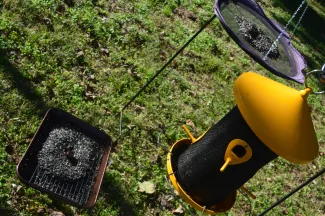
Some birds, like juncos and most sparrows, are ground feeders, gathering seeds and other plant materials which fall to the ground. Other birds are more adapted for feeding off the seed heads or in shrubbery and seem to feel more comfortable at a feeder set about table top height. Chickadees, titmice, pine siskins and other woodland species naturally feed in the tree canopy. They will readily come to the rims and perches of feeders hanging five to eight feet high. Birds forced to frequent feeders which are out of their natural preferred foraging areas are often ill at ease.
Birds also feel more comfortable at feeders that are located near escape cover (brush piles, shrubbery, or trees). They fly back and forth from feeder to cover. This behavior actually results in less crowding at feeders and allows more lengthy and intensive use. If cats are in the neighborhood, it may be a good idea to keep feeders at greater distances from cover than would otherwise be advisable. A good rule of thumb is that feeders should not be much over 5-10 feet from cover of some kind.
Successful Bird Feeding Tips
- Use at least eight to 12 feeders placed in two to three clusters to attract the greatest diversity of bird species. Place feeders at varying heights.
- Keep spillage and waste to a minimum. Put out food less often if it is going to waste.
- Provide protective cover from predators. Place the feeder 5-10 feet from a brush pile or thick shrubbery that can serve as excellent escape cover but not so close that they set up the perfect hide for ambushing predators like house cats.
- Place the feeder where it can be easily seen and enjoyed from a patio, window, or porch.
- Clean feeders and ground areas underneath them regularly.
- Protect food from inclement weather. Wet, moldy grain is unhealthy for birds.
- More About Bird Feed
Most people who feed wild birds may not be aware of various bird's preferences and needs. As a result, most people probably use the widely available commercial seed mixes. Some of these seed mixes are good, but others add a lot of filler like buckwheat, milo, and other grains. When buying these mixes, look at the ingredients and select those that contain mostly the more preferred foods like sunflower seeds and millet. Buying these seeds in bulk and mixing them yourself can actually save money as well as allow you to offer just those seeds most attractive to birds. A mix of white proso millet and solid black oil-type sunflower seeds is a good one.
Thistle, or niger, a tiny black seed imported from India, is highly desirable to some species including goldfinches and pine siskins. Because niger seed is expensive in comparison to other seeds, a hanging tube feeder, where the birds can take one seed at a time, is the most efficient. Thistle bag feeders are also available but should not be used where there are squirrels as they are easily damaged.
Image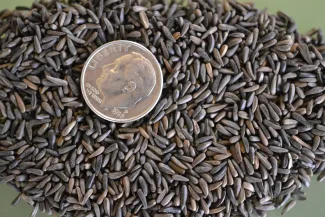 Jena Donnell/ODWC
Jena Donnell/ODWCTo save money, particularly during times of heavy visitation, try feeding birds a limited amount several times a day. To limit waste of spilled seeds, many feeders now come with "catch" trays that can be attached underneath. Proper storage of seeds bought in bulk is also important. Leaving seeds and grain in bags invites rodents, insects and spoilage. A galvanized or plastic trash can with a tight-fitting lid makes a good storage container.
To attract specific birds, offer their preferred seed choices.
Northern Bobwhite Whole and cracked corn, whole oats, soybean seeds, and hay chaff Mourning Dove Black oil sunflower seeds, red and white proso millet, German millet, and niger Carolina Chickadee Black oil and blackstripe sunflower seeds, and peanut kernels Tufted Titmouse Peanut kernels, blackstripe and black oil sunflower seeds Northern Cardinal Sunflower seeds of all types Eastern Towhee Sunflower seeds of all types, red and white proso millet Song Sparrow Red and white proso millet White-throated Sparrow Black oil and blackstripe sunflower seeds, sunflower kernels and pieces, red and white proso millet, peanut kernels. White-crowned Sparrow Black oil sunflower seeds, sunflower kernels and pieces, red and white proso millet, peanut kernels, and niger Harris's Sparrow Sunflower seeds of all types, red and white proso millet, and peanut kernels Dark-eyed Junco Red and white proso millet, canary seed, and finely cracked corn Purple Finch Sunflower seeds and kernels Pine Siskin Niger, and black oil sunflower seeds American goldfinch Niger, and black oil sunflower seeds Suet is a food that is particularly useful to certain birds during winter because of its high energy content. Suet specifically refers to the fat located around beef kidneys and loins. This fat has the best consistency for attracting birds. It is not a good idea to use suet during the summer or any time that outdoor temperatures are warm enough to turn it rancid.
Image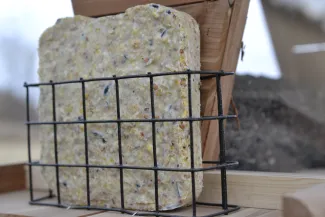 Jena Donnell/ODWC
Jena Donnell/ODWCMany people enjoy making special "suet cakes" by melting down beef fat and adding mixtures of peanut butter, honey, corn syrup, corn meal, or various seeds and grains. Suet cakes are best suited to elevated plastic or metal baskets or within hanging cheesecloth or mesh bags. In locations where freezing temperatures are the rule, it is recommended that metal baskets have a protective plastic coating. Bare metal may be dangerous to a bird's feet, tongue, or eyes in such weather.
Fruit is appealing to some bird species, particularly those which eat insects during the spring and summer months. Mockingbirds are partial to grapes and raisins. Orioles may come to sliced oranges nailed to branches or wooden posts. Apples set out on the ground or on a low-lying platform feeder are likely to attract robins. Squirrels will also be attracted to this offering.
Image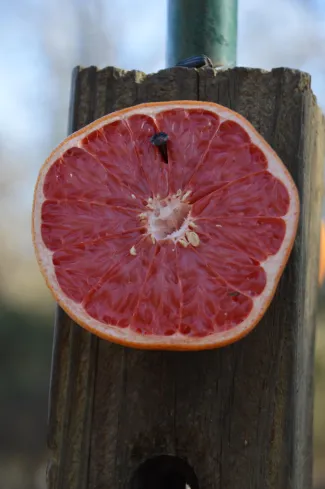 Jena Donnell/ODWC
Jena Donnell/ODWCSometimes birds will wait until the fruit softens before partaking of it, so don't be too impatient with this offering.
A food category which is highly specific to hummingbirds is sugar water. Orioles and a few other species may sample this mixture as well. The best solution is 80% water to 20% sugar, or a ratio of four to one. Boil the water before mixing the solution and then wash the dispenser with hot water every three days to discourage potentially harmful molds and prevent fermentation. Honey is not recommended for mixing with water; it is a likely medium for the growth of a fungus that can infect the tongues of hummingbirds.
A varied backyard feeding program might include:
- Providing sunflower seeds, peanuts, and fruit on platform or hopper feeders about 4 feet off the ground. Also, different seed types can be offered via tube-type feeders. Cardinals, finches, and grosbeaks will readily feed from these types of feeding stations.
- Offering thistle or finch mixes, which are highly desirable to finches and pine siskins. Due to its expense compared to other seed types, thistle should be dispensed from a hanging tube feeder and not placed in a platform or hopper feeder.
- Spreading millet and cracked corn on the ground to attract doves, towhees, juncos, quail, and sparrows. Spread these foods away from brush to attract doves and near brush to attract towhees. This is especially attractive to migrant and wintering birds in fall, winter, and spring. If mice, rats, or cats are a neighborhood problem, don’t feed on the ground.
- Suspending or attaching a suet feeder from a tree limb to feed insect-eating birds such as woodpeckers and bluebirds. Warm temperatures will turn suet rancid, however, so rather than feed suet or other animal fat-based foods in the summer, you might consider putting out a mixture of one-part lard, one-part peanut butter, and two-parts cornmeal.
- More About Bird Feeders
Bird feeders range from simple, inexpensive, homemade types to a variety of store-bought styles, some quite ornate. Offerings to ground feeding birds can be in a homemade, shallow wooden trough-type feeder. Table top-level feeders can also be this simple, mounted on a pole or other stand. The trend in commercial bird feeders has been toward small compact models that protect food from the weather and have features to reduce competition. These include the tube type and globe-shaped hanging feeders.
The tube feeder is a cylinder of clear glass or plastic. There are usually six or more circular feeding outlets provided with perches. This feeder caters to the feeding habits of small woodland birds like the chickadee and tufted titmouse along with the finches - goldfinch, purple finch, and pine siskin. The perches are too small for accommodating larger birds like cardinals and blue jays. Undesirable birds, such as house sparrows and starlings, feel more uncomfortable on such an unstable hanging feeder. Globe feeders are also too unstable for less desirable species, particularly since perches are not even provided. The food is held in the center of the plastic globe and the birds perch right on the rim of the circular opening.
Image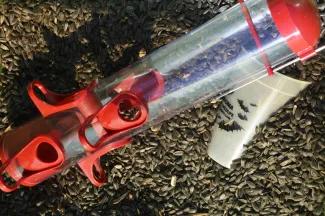
Hopper feeders usually have a sloping roof, glass or plastic sides, and a small tray where birds can feed. Because of the glass on one or two sides, it is easy to tell at a glance if more food is needed. Larger birds like cardinals feel comfortable at this feeder and it is quite stable, even when suspended.
Image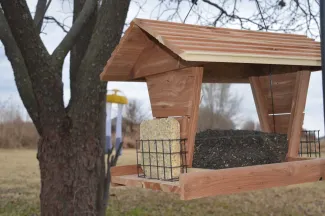
Several types of hummingbird feeders, glass and plastic, are available on the market. A perch at the feeder will encourage hummingbirds to remain there for longer periods of time as well as make the feeder more accessible to other birds.
Image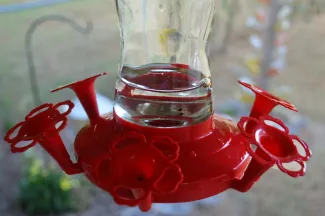 Jena Donnell/ODWC
Jena Donnell/ODWCTo increase your chances for success with hummingbirds, be sure to place the feeder near brightly-colored flowers, particularly those kinds that are fed upon by hummingbirds. It is always desirable to provide a natural food source along with an artificial one.
Get More Tips for Attracting Hummingbirds
There are other kinds of feeders, some of which can be attached directly to windows. Some feeders are specifically made for certain food types.
- Feeding Station Upkeep
Regardless of the type of feeding station you create, or the bird food you choose to offer, a regular cleaning schedule should be implemented in any bird feeding program. Keep your bird feeders clean by washing in a one-part bleach to nine-part water solution at least two to three times a year. Rotating feeding stations and cleaning the area directly under feeders with a rake or leaf blower can also help keep your feeding station open for business. Bird baths should be scrubbed at least once a day.
When birds congregate at feeders or bird baths, there is a possibility that bacteria and diseases can spread.
- Birds visiting feeders may come in contact with the Salmonella bacterium, which is spread through droppings. Common symptoms include lethargy, diarrhea and swelling of the mouth and crop. Birds healthy before the infection are often able to fight the infection, but stressed or young birds may struggle more.
- House finches are susceptible to a bacterium that can live in the birds’ tear ducts and may cause “house finch eye disease.” The bacterium causes the birds’ eyelids to swell and crust over. It can be spread to other house finches when infected birds come in contact with seed hulls and other birds. House finches with the disease are more prone to predation as their sight and flight are impaired.
- Birds in Mid-Atlantic and Midwestern states also have succumbed to a “mystery” illness, but this mortality event has not yet been detected in Oklahoma. Symptoms appear similar to the house finch eye disease, but the disease has been affecting nestling and fledgling American robins, grackles, blue jays, red-winged blackbirds and European starlings. No definitive cause of the disease has been identified.
Should sick or symptomatic birds be visiting feeders, biologists recommend disinfecting the feeder and cleaning under the feeder immediately. The feeding station should be closed for 5 – 7 days to allow the sick birds to disperse and recover without contaminating other birds at the feeder. When the feeding station is reopened, it should be in a new location over “fresh” soil that is not potentially contaminated. Continued monitoring is encouraged; remove feeders if sick or symptomatic birds reappear. Neighbors with feeding stations also can be alerted so they can be vigilant to the possibility of sick birds at their feeders.
- Common Bird Feeder Questions
How can I keep squirrels from eating all my bird seed?
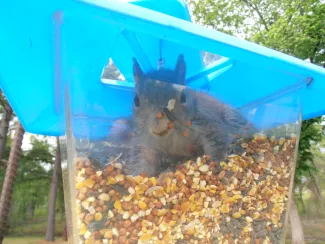 Phyllis Latham/Readers' Photography Showcase 2015
Phyllis Latham/Readers' Photography Showcase 2015This is probably the most frequent question from people who want to feed wild birds. Many of us enjoy watching squirrels in our backyards but the expense of keeping up with a squirrel's appetite while trying to feed wild birds can be discouraging. Again, the idea of feeding limited amounts on a timetable, particularly during milder weather, can save you money. Offer squirrels food at an easy access feeder and this will free up your other feeders for your bird customers.
If this doesn't solve the problem and squirrels are still dominating feeders to the exclusion of the birds, there are other alternatives. Some bird feeders available commercially are "squirrel proof." If you don't want the expense of a new feeder, you can squirrel proof your own. With pole supported or hanging feeders you can attach a metal or plastic shield around the access points. Or, suspend your feeders on wires between two supports (beyond jumping distance) and cover the wires with one inch plastic tubing. This makes for very insecure footing for even the acrobatic squirrels.
The challenge in solving the squirrel problem is keeping the feeders out of the jumping range while still close enough to cover needed by the birds.
What do I do if a bird flies into my window?
Birds usually blunder into windows because of optical illusions. The window may appear to actually be an opening, or it may be reflecting tree branches and look like a perch site or escape cover. Applying a visual barrier on the exterior side of the window in a grid or line pattern may help by reducing the transparency and reflectivity of the glass.
Birds flying into windows often only momentarily stun themselves. If this happens, the bird may need some assistance against predators while they recover. Place the bird into a darkened container. A paper bag works well. Twist the top and leave the bag in a quiet, safe place for an hour or so. Darkness will keep the bird quiet and prevent possible further injury from struggling. Be sure to release the bird before nightfall or wait until morning.
What should I do for baby birds that have fallen out of a nest?
Generally, it is much better to return an uninjured baby bird to its nest than try to care for the bird yourself. Often young birds that have fallen from the nest and assumed abandoned have actually not been forgotten by the natural parents. Returning these birds to their own nest or placing them off the ground in nearby trees or shrubbery will allow the parents to resume care. A young bird will not be rejected by its parents just because it has been touched by humans. Most birds have a poor sense of smell.
As baby birds grow in the nest, they become larger, often noisier, and produce more scent, so the nestlings become more vulnerable the longer they stay in the nest. One way that parent birds adapt to that risk is by leading the chicks out of and away from the nest before they're fully capable of flying. They attempt to scatter and hide the nestlings in places close by where there's cover, in that way a predator may find one or two chicks but not the entire brood.
If the young bird has become injured, its chances for survival are questionable. Remember that the loss of individual animals is a normal occurrence in nature. It is sometimes best to let nature take its course.
How do I discourage the starlings and house sparrows from coming to my feeders?
To solve the sparrow problem, develop your feeding program around small, hanging feeders that offer insecure footing. Avoid offering some of the sparrow's favorite foods like cracked corn, wheat and bread. Sunflower and thistle are also mildly popular with sparrows so they should be offered only in hanging feeders. There is a risk in this method, however, that you may be discouraging other birds like juncos and Harris's sparrows.
Starlings can really be bullies at a feeder. Luckily, they can be more easily discouraged from visiting feeders than house sparrows, without seriously inconveniencing your other guests. Unlike most birds, starlings like to feed late in the morning and early in the afternoon, so try feeding at other times like early morning or late afternoon. Again, avoid bakery items and other scrap type foods if you have problems with starlings. Stick to thistle, sunflower, millet and suet to best encourage desirable native bird species so they can be trapped and removed.
Don’t forget the drinks! Offering birds water – for both drinking and bathing – is just as important in winter as summer. Hanging waterers can be an option if a natural water source isn’t nearby, or a birdbath can provide both drinking and bathing water. Another bonus for birdbaths: Clean feathers are better able to lock out the cold so clean birds stay warmer!
Additional bird feeding information may be found in the Wildlife Department’s “Landscaping for Wildlife” guide. The full guide can be viewed here.
